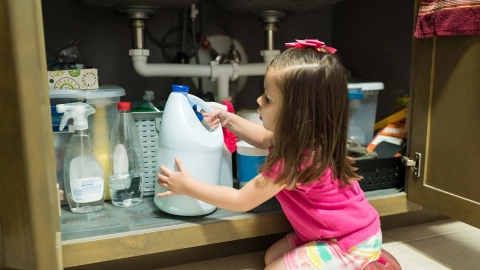Healthy living Are chemicals in clothing all safe?
It is not possible to produce textiles, for example clothes, without chemicals. But can these substances also affect people’s health? And how can you tell if clothing is completely safe?
At a glance
- Clothing labels specify the materials contained, but not the chemicals used during production.
- Special chemical substances can make clothing crease or water resistant, for example.
- Some substances, such as certain dyes, are now prohibited due to health concerns.
- Many other chemicals are permitted in textile production and can trigger contact allergies in rare cases.
- Textile labels (“ecolabels”) can act as a guide when looking for clothing that is non-harmful to health.
Note: The information in this article cannot and should not replace a medical consultation and must not be used for self-diagnosis or treatment.

Chemicals in clothing: what does the label reveal?
Clothing labels reveal the textile fibers from which a garment is made. However, they do not reveal which chemicals were used and incorporated during production as the European Regulation on Textile Labeling does not require manufacturers to provide this information.
Numerous chemical substances are needed to produce clothing textiles. These can create a colorfast dye, allow water-resistant breathability, make a garment crease resistant or combat body odor, for example. Depending on the desired garment properties, different numbers of chemical substances can be used. It is not possible to produce textiles without any chemicals.
What potentially harmful chemicals can be found in textiles?
The chemicals contained in clothing do not usually cause health problems. However, some people can have contact allergies – although even that is extremely rare.
Formaldehyde: textile agent for form stabilization
Formaldehyde is not only found in clothing, but also in many other products. For example, as a component in the adhesive used for furniture and floor coverings. In the case of textiles, it is particularly used to make tops crease resistant and help them hold their shape. Phrases such as “non-iron shirt” or “crease-free” may indicate the use of formaldehyde.
In the EU, formaldehyde is classed as a hazardous substance with carcinogenic and allergenic properties. Studies have confirmed that certain concentrations of formaldehyde in the air can have a carcinogenic effect. However, the concentrations transferred to the air by treated textiles do not pose this risk. In theory, clothing that has been treated with formaldehyde can trigger a contact allergy upon skin contact. However, the limit values set in the European Union are so low that no contact allergies can generally be triggered. The limit for formaldehyde in textiles is 75 milligrams per kilogram with the exception of jackets, coats and upholstery, for which a limit of 300 milligrams per kilogram applies until the end of October 2023.
Dyes: carcinogenic azo dyes now prohibited
There are about 4,000 dyes with very different chemical properties that can be used to dye clothing. The large group of azo dyes includes some dyes that can be broken down into carcinogenic compounds. This breakdown can occur in the liver, in the intestines and possibly through skin bacteria. As a result, clothing manufacturers based in the European Union no longer use certain azo dyes that break down into carcinogenic compounds and are therefore prohibited by the European Chemicals Regulation REACH. Clothing imported into the EU is also no longer permitted to contain these substances.
The primary triggers of dye-induced contact allergies are certain disperse dyes, in particular dark, yellow, orange and red dyes. Due to their fat solubility and small molecule size, disperse dyes can be better absorbed by the skin than other dyes. The Federal Institute for Risk Assessment (BfR) advises against using certain disperse dyes for clothing textiles. Studies have shown that most manufacturers follow these recommendations.
Biocides in clothing: combating body odor with chemicals
The term biocides is generally used to refer to substances and products that combat germs and pests. According to legislation on biocides, all biocide products must gradually undergo an authorization procedure. When it comes to biocides in clothing, these are often agents that are used to combat bacteria or protect against biting insects such as mosquitoes and ticks. One such antibacterial substance is silver, which is incorporated into textile fibers to suppress body odor caused by the formation of bacteria. However, it can sometimes also disrupt the balance of the skin’s own bacteria (skin flora) and irritate the skin. The Federal Institute for Risk Assessment (BfR) therefore advises consumers to weigh up the benefits against the risks of clothing textiles with antimicrobial properties.
Chromium salts in leather tanning: problematic for people with sensitive skin
Chromium salts are used to tan leather. Chromium(VI) compounds can sometimes be created from chromium salts in leather shoes, leather belts and other leather products. Chromium(VI) compounds are classed as substances of very high concern (SVHC) and can cause contact allergies in some people. To protect people’s health, a legal limit of 3 milligrams per kilogram has been established for chromium(VI) in leather products that come into contact with the skin. With good manufacturing practice and good production conditions, any detrimental effect on consumer health is unlikely. However, even chromium(VI) concentrations below this limit can still be problematic for people with sensitive or sensitized skin. In such cases, people can opt for vegetable tanned leather.
Nickel: a frequently used substance known to trigger allergies
Nickel is not only used to make cheap fashion jewelry, but also more expensive silver and gold alloys. And even more importantly for everyday life, it is often a component in rivets on jeans, belt buckles, zippers and buttons.
Nickel is the most common cause of contact allergies, i.e. the most common contact allergen. However, since the EU regulations were updated, nickel allergies have become far less prevalent.
How are consumers protected?
Restrictions and bans on use have been established for certain substances to prevent chemicals in clothing from harming people’s health. Manufacturers must comply with the provisions of the Consumer Goods Ordinance (Bedarfsgegenständeverordnung), the Chemicals Prohibition Ordinance (Chemikalienverbotsverordnung), the REACH Regulation and the EU Biocidal Products Regulation. The federal states monitor compliance with these regulations by testing samples.
Textiles manufactured using the latest technology are not expected to have any detrimental effect on health. However, even the permitted use of chemicals can sometimes be linked to contact allergies. If you consider that everyone has constant close skin contact with textiles though, these contact allergies can be classed as rare.
How can people protect themselves from harmful substances in textiles?
When you look at clothing in a shop, you cannot tell which chemicals were used in its production. This is because manufacturers are not obliged to provide this information. However, consumers are still able to obtain information about any substances of very high concern (SVHC) that are contained prior to buying clothes. Within the European Union, clothing manufacturers must provide information on request if the substances of very high concern used exceed a certain limit – including to private individuals. This is stipulated in the European Chemicals Regulation REACH.
Alternatively, you can download the free smartphone app “Scan4Chem” from the website of the EU-funded project “LIFE AskREACH”. This enables you to scan the barcode on clothing labels, but also on the labels on sports equipment or toys, and request information about any harmful substances that are potentially contained.
In addition to the specific information provided by manufacturers, clothing items themselves can also provide indications of potential substances that affect health. When purchasing and wearing clothes, you should therefore pay particular attention to the following points:
How the textiles smell
If a piece of clothing in a shop or wardrobe has a pungent odor, this can indicate the use of problematic chemicals.
Washing instructions such as “wash separately”
If a label says “wash separately”, this indicates that the clothing’s color may bleed. Dyes that are easily soluble can also be transferred to the skin more easily.
Important: It is generally advisable to wash all new items of clothing prior to wearing them as this rinses away any chemical residues.
Claims such as “antibacterial” or “antimicrobial”
Added biocides, especially in sports textiles, are used to combat body odor but can sometimes irritate the skin and potentially disrupt the balance of the natural skin flora. You should therefore consider whether you can do without biocides in the clothes.
Prioritize light colors and wash clothes before their first wear
By buying non-dyed clothes, you can ensure that there are no dyes that will trigger contact allergies when they are worn. If you do opt for dyed clothes, always wash them before wearing them for the first time.
Textile labels (“ecolabels”) as guidance
To date, there are no binding eco-standards for clothing. However, there are a number of textile labels that either assess the pure product properties or consider the entire product cycle from extraction of the raw materials to the product’s disposal.
Information about the different textile labels can be found at siegelklarheit.de.
- Allergieinformationsdienst. Allergene in der Kleidung. Aufgerufen am 06.05.2021.
- Allum – Allergie, Umwelt und Gesundheit. Farbmittel. Aufgerufen am 06.05.2021.
- Allum – Allergie, Umwelt und Gesundheit. Gesetzliche Regelungen und Textilsiegel. Aufgerufen am 06.05.2021.
- Allum – Allergie, Umwelt und Gesundheit. Tipps: Textilien sicher tragen. Aufgerufen am 06.05.2021.
- Bundesamt für Justiz. Bedarfsgegenständeverordnung. Anlage 9 (zu § 10 Abs. 3): Bedarfsgegenstände, bei denen bestimmte Inhaltsstoffe anzugeben sind. Aufgerufen am 06.05.2021.
- Bundesinstitut für Risikobewertung (BfR). Einführung in die Problematik der Bekleidungstextilien. Aufgerufen am 06.05.2021.
- Garg A, Thyssen JP, Uter W, et al. Nickel allergy following European Union regulation in Denmark, Germany, Italy and the U.K. British Journal of Dermatology 2013. 169(4): 854-858.
- Bundeszentrale für gesundheitliche Aufklärung (BZgA). kindergesundheit-info.de. Farb- und Hilfsstoffe in der Kleidung. Aufgerufen am 06.05.2021.
- Ministerium für Umwelt, Landwirtschaft, Natur- und Verbraucherschutz des Landes Nordrhein-Westfalen. umwelt.nrw.de. Kleidung. Aufgerufen am 06.05.2021.
- Umweltbundesamt (UBA). Kann ich an der Bekleidung erkennen, welche Chemikalien/Schadstoffe enthalten sind? Aufgerufen am 06.05.2021.
- Umweltbundesamt (UBA). Schutzmittel für Fasern, Leder und polymerisierte Materialien. Aufgerufen am 06.05.2021.
- Umweltbundesamt (UBA). Welche gesetzlichen Regelungen gibt es zu Schadstoffen in Bekleidung? Aufgerufen am 06.05.2021.
- Verbraucherzentrale Nordrhein-Westfalen. Leder mit Chrom VI: Wie gefährlich ist das? Aufgerufen am 06.05.2021.
As at:






